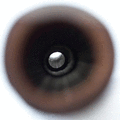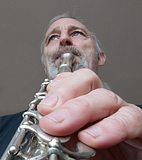Mujitsu and Tairaku's Shakuhachi BBQ
World Shakuhachi Discussion / Go to Live Shakuhachi Chat
You are not logged in.
Tube of delight!
#1 2008-06-18 15:19:34
- Seth
- Member

- From: Scarsdale, NY
- Registered: 2005-10-24
- Posts: 270
Jinashi and length...
Dear Jinashi Groupies:
I understand why jinashi people love jinashi flutes - but why do they almost always go for long (2.4 +) jinashi flutes?
Do the special sound characteristics of jinashi simply not come out in a 1.8?
Would anyone consider playing a jinashi 1.5 for minyo?
Why do jinashi makers seem to be ever stretching towards longer and longer lengths?
Respectfully,
A 1.8 Jiari Player
Offline
#2 2008-06-18 17:03:30
- radi0gnome
- Member

- From: Kingston NY
- Registered: 2006-12-29
- Posts: 1030
- Website
Re: Jinashi and length...
Seth wrote:
Dear Jinashi Groupies:
I understand why jinashi people love jinashi flutes - but why do they almost always go for long (2.4 +) jinashi flutes?
I can only guess, and since I don't know Japanese traditional music I might be way off base. But my guess would be that the lower pitches are desirable and that's about the length where the flutes stop responding fast enough.
Seth wrote:
Do the special sound characteristics of jinashi simply not come out in a 1.8?
There are plenty of 1.8 jinashi's around so I doubt that it has anything to do with the lack of the jinashi special sound.
Seth wrote:
Why do jinashi makers seem to be ever stretching towards longer and longer lengths?
My guess to that question is "because they can".
BTW, have you ever tried a long jiari. I have a 2.4 jiari and I love it.
"Now birds record new harmonie, And trees do whistle melodies;
Now everything that nature breeds, Doth clad itself in pleasant weeds."
~ Thomas Watson - England's Helicon ca 1580
Offline
#3 2008-06-18 17:28:22
Re: Jinashi and length...
Seth wrote:
Why do jinashi makers seem to be ever stretching towards longer and longer lengths?
Seth,
One thought that comes to mind is that jinashi makers may be less bound to convention. Perhaps there is more freedom to let the material dictate the pitch and length.
Offline
#4 2008-06-18 18:07:17
- Tairaku 太楽
- Administrator/Performer

- From: Tasmania
- Registered: 2005-10-07
- Posts: 3226
- Website
Re: Jinashi and length...
There are great jinashi in all lengths and you can use them for anything. One of my best flutes is a jinashi 1.6.
The reason most of the long flutes you see are jinashi is because there is no point in filling up a long piece of bamboo with heavy ji. And also because the tolerances are greater in long flutes and it's easier to create them using only subtraction.
'Progress means simplifying, not complicating' : Bruno Munari
http://www.myspace.com/tairakubrianritchie
Offline
#5 2008-06-19 00:49:22
Re: Jinashi and length...
Seth wrote:
Dear Jinashi Groupies:
I understand why jinashi people love jinashi flutes - but why do they almost always go for long (2.4 +) jinashi flutes?
Do the special sound characteristics of jinashi simply not come out in a 1.8?
Would anyone consider playing a jinashi 1.5 for minyo?
Why do jinashi makers seem to be ever stretching towards longer and longer lengths?
Respectfully,
A 1.8 Jiari Player
Hi Seth
It's an interesting question. I get the feeling that most people who prefer jinashi are honkyoku players. And many honkyoku players prefer longer shakuhachi, because they often feel the deeper sound suits that music better. So that may be one reason.
Then, if we think of the differences between the genres of music, we find something else too. Honkyoku is solo, and can be played at any length. Sankyoku is ensemble (and much Gendaikyoku too), and generally requires using a 1.8. Now two factors:
1) For solo music, the fundamental pitch of the instrument doesn't matter, e.g. if the whole shakuhachi is 50 cents sharp, it doesn't matter. But when you play in ensemble, that starts to matter.
2) a) The relative pitches matter less in solo than in ensemble, for example if your otsu no re is 20 cents sharp, playing with a koto in unison, you will really notice it, and it will sound, to most ears, bad. However, that will be far less noticeable (to most people) if played solo. It's the two notes sounding at once that (when out of tune) give the dissonance.
b) There is also a personal taste factor. Much of the honkyoku community has a different sense towards pitch than the ensemble community. That is, there is more acceptance of "variable pitch" within the honkyoku community. That itself varies from group to group within the community. This is connected to a sense of honkyoku not being perceived as "music".
Factor 1) means that music which requires a 1.8 (mostly ensemble) will need exact sizing. That is far more difficult with nobe-kan. Most jinashi are nobekan (one piece). For that reason, 1.8s will tend to be 2 piece jiari. And jinashi could be any length, and anything in between.
Factor 2) means that ensemble players (most of the 1.8 customers) will require an accurately tuned instrument. That is far easier and more common with a jiari. Another factor would be volume, which many ensemble players want more of so they can be heard. Jiari are commonly louder than jinashi.
This may help to explain some reasons behind the relative lack of shorter jinashi. There are other reasons too.
As for the special characteristics of jinashi for 1.8, on my website there is an mp3 of shika no tone, the first part being played by a 1.8 jinashi, and the second by a 1.8 jiari. Of course every shakuhachi has it's distinctive tone, so this is not to illustrate the difference between jinashi and jiari. But just one example of each:
http://justinshakuhachi.googlepages.com … achimaking
Can you hear a difference?
Best wishes
Justin
http://senryushakuhachi.com/
Last edited by Justin (2008-06-19 00:54:37)
Offline
#6 2008-06-19 03:24:51
- udo.jeromin
- Member

- Registered: 2007-05-07
- Posts: 72
Re: Jinashi and length...
1.7-2.0 seem to be common lengths for old jinashi (beautiful examples at John Singer's web site).
Going longer in jinashi seems to be a more modern development, started by people like Nishimura and perhaps Watazumi?
udo.
P.S.: I have (and play) 1.7 and 1.8 jinashi-kans and these have very distinctive sound qualities, different from the jiari I own (and also occasionally play). So, no, I think jinashi sound qualities do come out in short instruments as well (however, my experience is limitied).
Last edited by udo.jeromin (2008-06-19 03:36:02)
Offline
#7 2008-06-19 04:01:49
Re: Jinashi and length...
Seth wrote:
Dear Jinashi Groupies:
I understand why jinashi people love jinashi flutes - but why do they almost always go for long (2.4 +) jinashi flutes?
Do the special sound characteristics of jinashi simply not come out in a 1.8?
Would anyone consider playing a jinashi 1.5 for minyo?
Why do jinashi makers seem to be ever stretching towards longer and longer lengths?
Respectfully,
A 1.8 Jiari Player
Hi Seth.
I think you have got quite a good idea by now, but I would like to elaborate a little more.
If you see Edo period shakuhachi, far most of them are shorter than 2.4. The tendency of going longer is newer, but that doesn't mean there are no long Edo period shakuhachi. There are, but the majority is shorter.
If you listen to historical recordings, you get the sense that honkyoku was played faster and more light-hearted than what many play today. Today it seems that we are attracted to a 'darker' tone colour, and we play the pieces slower. The longer ones fits well our taste in playing style.
I have tried to play jinashi in min'yo. But the min'yo singers I collaborated with do not like jinashi, because they feel it is too close to the voice. I have never met anyone specialising in min'yo on jinashi, but no-one says it can't be done.
I personally stretch for longer length to challenge myself, and most of all because I LOVE low pitch instruments. If I were to begin studying a new instrument I would choose double bass. But that is personal!
Ok, have to run. Going to St Ives, Cornwall to play at the Tate museum there. St Ives is so beautiful. I am looking forward to be playing among palm trees and succulents there.
I am a hole in a flute
that the Christ's breath moves through
listen to this music
Hafiz
Offline
#8 2008-08-23 11:07:31
- Toby
- Shakuhachi Scientist

- From: out somewhere circling the sun
- Registered: 2008-03-15
- Posts: 405
Re: Jinashi and length...
One reason is that in the longer flutes the bore is (generally) of a more ideal diameter for the length. In a normally-formed culm of 1.8 length and a nice outer diameter the inner diameter is usually too wide for good response in the highs, which is the reason that jiaris came about in the first place. I have a 2.6 jinashi I made in one of John Neptune's workshops that plays three octaves flawlessly. I have yet to find a jinashi 1.8 that I can play at all in the dai kan.
Toby
Offline
#9 2008-08-24 01:23:47
Re: Jinashi and length...
Toby wrote:
I have yet to find a jinashi 1.8 that I can play at all in the dai kan.
Toby
Hi Toby
You'll have to try some of mine!
Justin
http://senryushakuhachi.com/
Offline
#10 2008-08-24 06:32:04
- Toby
- Shakuhachi Scientist

- From: out somewhere circling the sun
- Registered: 2008-03-15
- Posts: 405
Re: Jinashi and length...
Justin wrote:
Toby wrote:
I have yet to find a jinashi 1.8 that I can play at all in the dai kan.
TobyHi Toby
You'll have to try some of mine!
Justin
http://senryushakuhachi.com/
I'm looking forward to it :-)
Toby
Offline
#11 2008-08-25 03:12:10
Re: Jinashi and length...
Toby wrote:
I have yet to find a jinashi 1.8 that I can play at all in the dai kan.
Toby
Once you are down in length it is not that rare to find wellmade jinashi that can play all 3 octaves. The longest of mine that plays 3 octaves easily is a 2.55. I use it to play Betsuden Shika no Tone (the Watazumi version, which is a solo) since this piece make use of many daikan notes incl the 4th ro.
So you will meet some good 1.8 jinashi sooner or later. Have fun when you do!
I am a hole in a flute
that the Christ's breath moves through
listen to this music
Hafiz
Offline